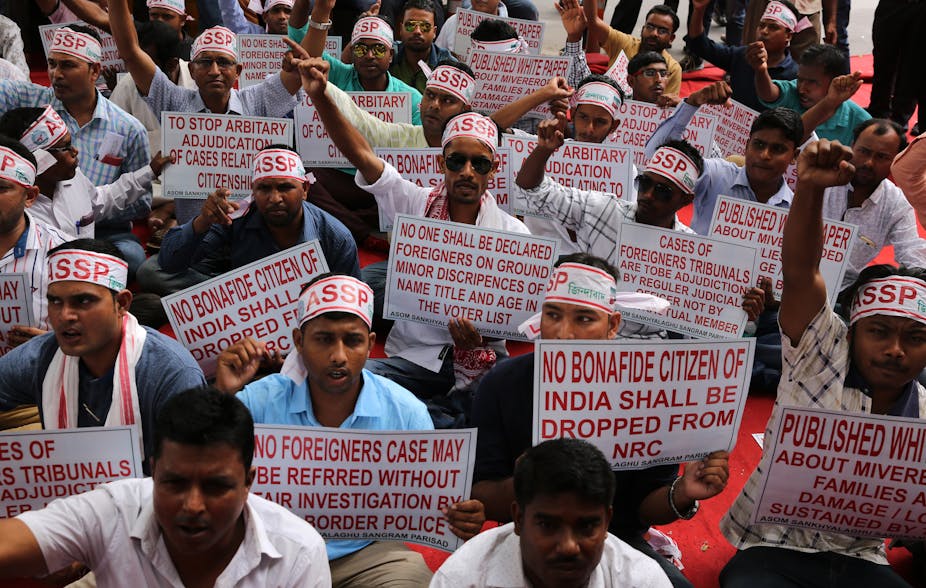Citizenship controversies have made repeated headlines in countries across the world in 2018. From the Windrush scandal affecting Commonwealth citizens in Britain, to the “Dreamers who were brought to the US by their parents as children, these scandals are inevitably tied up with the movement of people across borders, whose claims to citizenship have been thrown into question by hostile states.
Amid a worsening political environment for immigrants globally, governments have deployed ever more capricious mechanisms to certify citizenship, pushing the burden of authentication onto people themselves. This has vastly expanded bureaucratic control over individual lives – no more so than in India.
In late July, following years of controversy, India published the National Register of Citizens living in the eastern state of Assam, on the border with Bangladesh. This was the first time the list had been published since it was compiled in 1951 and the stated purpose was to identify "illegal immigrants”. Nearly 4m people risk losing Indian citizenship if they cannot prove that they are lawful citizens of the Indian state – a task complicated by the contested history of immigration into this region from Bangladesh. As deportation is neither being openly suggested nor politically feasible, those excluded face an uncertain future.
Successive amendments to India’s Citizenship Act of 1955 have inserted new conditions that must be retrospectively met by people suspected of living in the country illegally. The 1985 Assam Accord had set the benchmark here, declaring that anyone who entered the country after March 25, 1971, the day before the creation of Bangladesh, would be declared a foreigner and deported. In 2003, another amendment to the Citizenship Act excluded anyone born in India that has one parent who was an illegal immigrant at the time of their birth.
The latest twist is the 2016 Citizenship Amendment Bill which seeks to amend the 1955 Citizenship Act to allow “persecuted minorities” – Hindus, Christians, Sikhs, Buddhists, Jains and Parsis – from the neighbouring countries of Bangladesh, Pakistan and Afghanistan to gain Indian citizenship after six years of residence. The bill doesn’t have the same provision for Muslim sects such as Shias and Ahmadiyas, who face discrimination in Pakistan, and as such would alter the secular face of India’s citizenship regime. The proposed changes cater to the hardline Hindu agenda of India’s ruling BJP party, but they have caused strong protests in Assam as people fear the changes would legitimise immigration from Bangladesh.
Read more: Why India's new citizenship law is so controversial – and why some regions are angrier than others
There have been political tensions in Assam around the subject of Muslim immigration from Bangladesh for decades. And now, the fate of the excluded 4m people from the Orwellian National Register of Citizens depends on a long, drawn out bureaucratic process of verifying documents, pending hearings at 100 so-called “foreigners tribunals” established in 2015 for the task of determining illegal immigrants. These could have terrifying consequences, including eliminating women because their documents are worthless. The Indian state also does not care that documents may have been lost in destructive cyclones and floods.

This is the latest incarnation of a very old problem. Following partition in 1947, both India and Pakistan assumed the burden of adjudicating claims of citizenship that arose from multiple border crossings. This led to the evaluation of various identity documents (IDs) by officials, in order to determine citizenship. As the political commentator Niraja Gopal Jayal has explained, Muslims living in India and Hindus in Pakistan who fled to the other country for fear of religious persecution in those fraught early years could not find their way back easily. They had to obtain documentary proof such as permits in order to “return” and these documents were then subjected to years of scrutiny by officials.
Odisha’s alleged ‘infiltrators’
Laws do not always straightforwardly translate into political action and bureaucratic orders, but occasionally they do. Back in 2005, the government of the eastern Indian state of Odisha produced a list of 1,551 persons, declaring them to be anuprabeshkaris (infiltrators), who had supposedly arrived after the cut-off date in March 1971 or were born to someone who had.
Identifying such people amid entire villages with origins in East Bengal, later Bangladesh, all of whom had arrived in India and made their way to Odisha at different points and in different ways since the 1950s was an impossible task. Such identification was also not undertaken in a rigorous manner and produced incomprehension and fear among those named on the list. Their IDs, including voter cards and ration cards, were struck off. The authorities never deported them, and the matter grew cold.
Their “nullified” existence on paper has left a traumatic legacy of abrupt exclusion. They can scarcely access the meagre subsidies such as pensions or food rations provided by the state. They have problems with local Odiyas, native to Odisha, around fishing and are unable to lead a dignified social life. This is a community divided, even when the concerned immigrants were all Hindu, the majority religious community.
Excluded, not empowered

Throughout history, IDs have allowed states such as India to engage in verification and surveillance, silently infusing these practices with categories such as “desirable citizen” and “undesirable migrant”. In this way IDs have become key to regulating migrant movements. In Africa, states such as Zimbabwe and Kenya have used IDs to police and provide different entitlements to different groups of people.
IDs don’t just certify citizenship. They reveal how citizenship is an unequal and uneven political and social playing field. They seek to empower people, but in practice, they often exclude them. The Indian state’s ongoing experiments with digital identification cards (Aadhar), the possession of which is linked with a range of welfare schemes, have led to significant numbers of exclusions. The string of miseries for the poorest people, amounting to indignity, hunger, even death, leaves little doubt of the tyranny of IDs.

